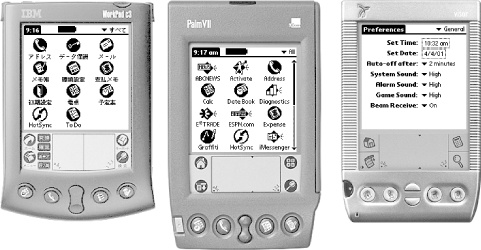POSE
POSE emulates, at the hardware level, a Palm handheld. It emulates a Motorola Dragonball processor, a display, and so on. Since the actual Palm OS handhelds also contain ROM, the emulator must deal with this by requiring ROM as well. It uses a file containing a ROM image. POSE can emulate any OS version, depending on the ROM you provide. Figure 7-1 shows POSE emulating some different devices.

Figure 7-1. POSE emulating an IBM Japanese Workpad c3, a Palm VII, and a Handspring Visor
Tip
POSE is based on Copilot, an application written by Greg Hewgill. Mac OS and Unix versions were created by others. A Palm tools engineer, Keith Rollin, began his job at Palm by doing a quick project to unify the disparate ports. Years later, he’s still hard at work on POSE, continually adding features and adding support for new hardware devices.
POSE is supported by Palm for Windows, Mac, and Linux/Unix. Better yet, source code is provided. You are free to make changes, but if you do, please contribute them back to Palm. Your enhancements may be incorporated in the main code base, making life better for everybody.
Note
POSE can be downloaded from http://www.palmos.com/dev/. You should always check Palm’s web site for the most recent version, as this tool evolves rapidly. It also comes with the Metrowerks CodeWarrior for Palm OS. In this chapter, we discuss POSE 3.2, the version current as of mid-2001. ...
Get Palm OS Programming, 2nd Edition now with the O’Reilly learning platform.
O’Reilly members experience books, live events, courses curated by job role, and more from O’Reilly and nearly 200 top publishers.

